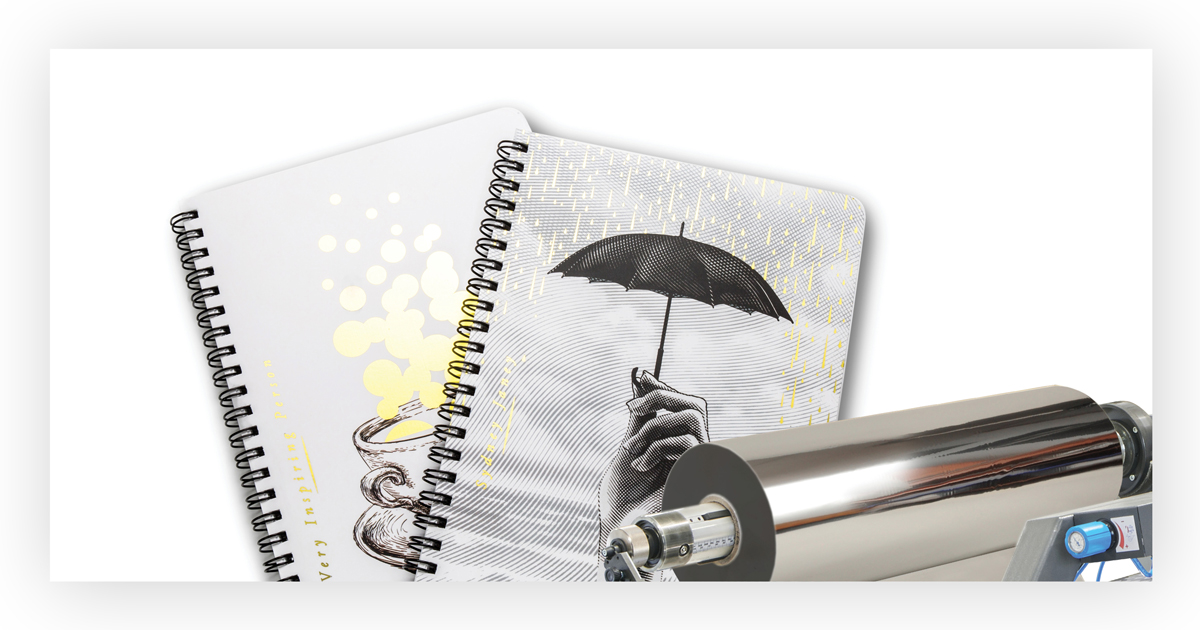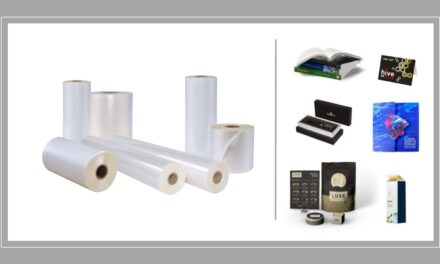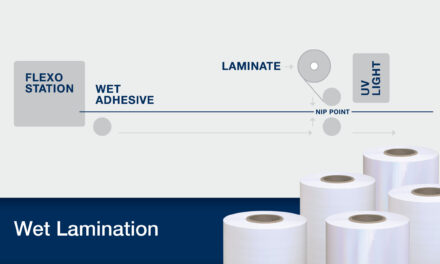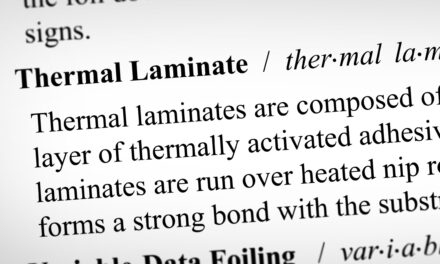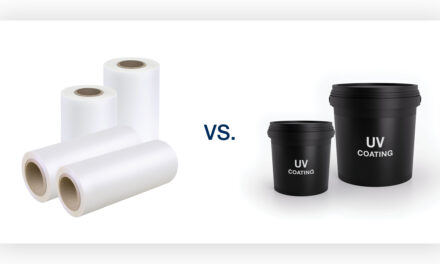WHAT IS FOILING?
Companies, brands, and service providers alike currently have more competition for consumer attention than ever before. Because of this, the ability to create striking packaging and marketing collateral has become absolutely vital to the long-term success of any business or brand. Within the print finishing industry alone exist dozens of value-add processes developed to give printed pieces a boost in their sensory appeal and increase the likelihood of a sale. Ranking high among the most popular embellishment methods, foiling is the process of adding a metallic effect to prints to create contrast between the foiled areas – typically words or central design elements – and the rest of the piece.
These foil effects are usually applied after the sheet or packaging has been printed and laminated or coated (although there are exceptions to this rule). The process uses long rolls of incredibly thin foil film that consists of plastic, metal, and adhesive layers. These foil films can come in gold, silver, copper, and a variety of bright colors, including holographic effects.
Foiling is an excellent way to add value to printed pieces and help designs pop, but printers who want to integrate the process into their workflow need to ensure they understand the different foiling methods and which one will best serve their operational needs. This article will cover the two major foiling methods: hot foiling and cold foiling.
WHAT IS THE DIFFERENCE BETWEEN HOT FOILING AND COLD FOILING?
While their names may seem like an obvious hint as to how these methods differ, both hot and cold foiling are complicated processes that are set apart by more than their temperatures. Each method involves different types of equipment and foil film and comes with unique limitations.
Hot Foiling
Also called foil stamping, hot foiling is performed by layering a foil film over a printed sheet and then pressing the foil into the surface of the sheet using a heated die. This die is typically made of metal and has a design etched into its surface. The foil films used for hot foiling include an incredibly thin adhesive layer that activates once the heat from the die warms it.
When heat and pressure are applied through the die, the foil adheres to the printed piece in a layer so thin it feels smooth against the rest of the sheet. Hot foiling can be combined with other finishing processes, including lamination. Printers can even use specialty laminates like those from Nobelus to create contrast with foil effects by using matte, soft-touch, scuff-resistant, and other types of finishes.
Cold Foiling
Cold foiling is similar to hot foiling in many ways: A thin foil film is layered overtop a printed sheet and then peeled away, leaving foil behind in a specific pattern. Unlike with hot foiling, however, the films used in cold foiling do not have a heat-activated adhesive coating. Instead, an image plate is used to transfer a liquid adhesive onto the printed sheet, much like how ink is applied in a specific pattern via plates to create part of an image.
The image formed by the adhesive is initially clear, but when the foil film is pressed against the sheet and pulled away, foil adheres only to places where adhesive is present, leaving behind a foil image. A UV or LED light cures the adhesive instantly. Cold foil can be overprinted to create unique colors, and it can also be combined with laminates for added protection and value-add effects.
Sleeking®
Also called digital foil transfer or variable-data foiling, Sleeking is a proprietary cold foiling method that enables smaller printers to use foil effects on-demand. The foil films used for Sleeking are designed to adhere directly to digital inks; no adhesive layer, image plates, or dies are necessary.
In this process, a sheet is first run through the digital press like normal. Next, the sheet is moved to a thermal laminating system where the foil film can be applied and pulled away, leaving behind foil wherever ink has been placed. There are two ways to perform Sleeking.
Basic Sleeking involves printing the parts of the image that will receive foil first and then transferring it to a laminator to receive the foil layer. Once the foil is applied, the sheet can be returned to the press to receive the rest of the ink. The sheet can then be overprinted, laminated, or coated if needed.

Laminated Sleeking requires that the non-foiled sections of the image be printed first and then laminated. Once the sheet has been laminated, it can be returned to the printer to receive more ink in any areas that will be foiled. Finally, the sheet is returned to the laminator so the foil layer can be applied.

To learn about Sleeking in more detail, check out our blog post: What Is Sleeking?
HOW TO CHOOSE A FOILING METHOD
Next, we’ll break down the requirements, benefits, and limitations for each of these foiling methods to narrow down which technique might be the best choice for individual printers. Specifically, we will see how equipment capabilities, average volumes, cost, and the importance of customization can impact which foiling method is most beneficial for a given printer’s needs.
Equipment Capabilities
Each foiling method requires unique machinery, from the press used to print the design to the components that perform the actual foiling.
Hot foiling is compatible with sheets produced using an existing offset, flexographic, or even digital press, but printers will need a dedicated hot foil stamping machine or module to perform the actual foiling process. The dies that stamp the image onto the sheet will need to be purchased separately.
Cold foiling can fit seamlessly into the workflow of any flexographic press as the adhesive can take the place of ink in the final deck on the station. The image plates used for cold foiling are identical to those used in the rest of the printing process in flexographic applications. Regarding offset presses, cold foiling is usually performed near- or off-line, although a few manufacturers produce in-line solutions. Due to the difference in speed between an offset press and these near-line cold foiling systems, printers may need to purchase multiple foiling machines to manage the output of a single press.
Because Sleeking foils adhere only to digital inks, Sleeking can be performed strictly by printers who own a digital press. Additionally, printers will need a thermal laminating system equipped with a Sleeking module, which includes a take-up/rewind mandrel for the liner layer that remains after the foil adheres to the ink.
Volume/Cost
Certain foiling methods are much more streamlined than others, but not every printer needs a high volume of foiled sheets. On-demand and high volumes will necessitate different types of foiling. Additionally, the costs associated with each foiling method need to be weighed against the expected increase in margins granted by a value-add process.
Hot foiling can be performed at high volumes with incredible speed and accuracy. When producing a high number of identical foiled designs is a printer’s top priority, there is no better solution than installing a hot foiling machine. However, because hot foiling requires a large equipment investment from the outset, printers should carefully consider how many projects will need foil on average to justify the entry cost.
Additionally, each project that requires a new design will require that specially made metal dies be ordered from a manufacturer and shipped to the facility before any foiling can be performed. These dies can be costly, and the time it takes to produce and ship a die can extend lead times significantly. For this reason, hot foiling is most suitable for extremely high-volume jobs that can spare time in pre-press and utilize a single die for the duration of the print run.
Cold foiling can produce a high number of foiled sheets quickly, albeit not as quickly as a well-tuned hot foiling workflow. The fact that the process is performed in-line on a flexographic press means print jobs typically flow smoothly and require less labor as the sheets do not need to be moved to separate finishing equipment. For printers who already utilize a flexographic press, adding cold foiling to the process can be an effective way to maximize margins with minor effect to volumes or lead times.
However, offset presses typically require that printed sheets be transferred from the press to nearby foiling equipment, and it can take multiple units to accommodate the output of a single offset press. For this reason, printers should consider if the increase in revenue will justify the equipment cost.
In contrast to the other two foiling methods, Sleeking is compatible with on-demand volumes only. Beyond the fact that it works solely with digital presses, which are typically much slower than their conventional counterparts, Sleeking is a multi-step process that requires the operator to transfer the sheet between the press and the laminator multiple times. Because of this, Sleeking is typically reserved for high-value jobs where margins are large enough to justify lengthier lead times.
Printers must also purchase a thermal laminating system with a built-in Sleeking module if they do not already own one. Still, Sleeking requires no metal dies or image plates, which means less time and money are spent in pre-press. Once the proper equipment is installed and the workflow is optimized, the only recurring costs are the Sleeking foils and the digital ink they adhere to.
Customization
Customization is becoming more and more popular as consumers seek out personalized invites, exciting seasonal and limited-edition products, and packaging made just for them. Many well-known brands have caught onto this trend, from subscription services and advertising firms to promotional events at conferences.
Both hot foiling and cold foiling are fairly limited in how much customization they can provide. Due to the fact that both methods make use of static dies and plates, they are most suited for high volumes of identical designs. The time it would take to design several new dies or plates, create them, and change them out multiple times over the course of a single job would negate any increase in revenue that comes from the personalized design.
On the other hand, Sleeking is an ideal way to offer brands seamless customization without increasing the cost of the job compared to a static foil image. As an example, consider a print job that consists of 200 wedding invitations. Each will have the same basic ink design with the announcement and date, but the customer wants an added flair: The names of the invitees need to be in foil.
Digital printing technology allows each individual invite to be programmed into the software as a unique job, resulting in variable-data prints that are produced just as quickly as an equal number of identical designs. There are no added costs or increased lead times, resulting in high-margin jobs that can help establish the printing operation as a specialty service provider.
HAVE QUESTIONS ABOUT SLEEKING?
Nobelus offers some of the highest quality thermal laminating systems and variable-data foiling films on the market. If you are the owner of a digital press or are considering purchasing a digital press, we encourage you to investigate how incorporating Sleeking as a value-add process could increase your revenue and expand your market opportunities.
If you have questions or just want to learn if Sleeking might be right for your operation, don’t hesitate to reach out through phone or email. Our in-house solutions experts know the print finishing industry inside and out and can help you determine which foiling method would fit best with your operational capabilities and goals.

